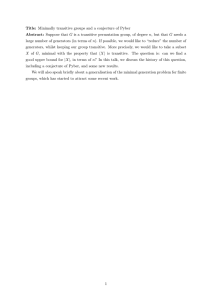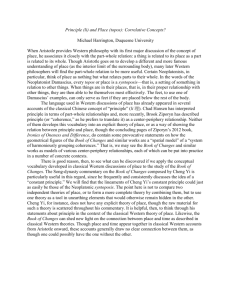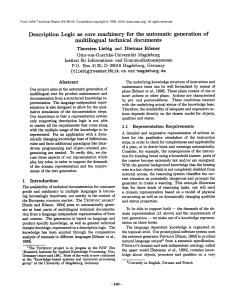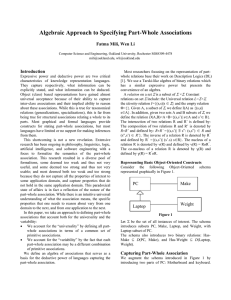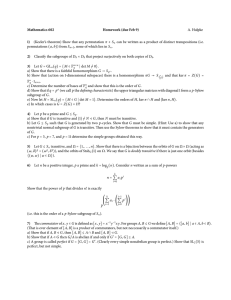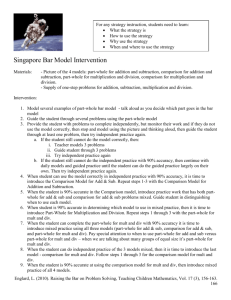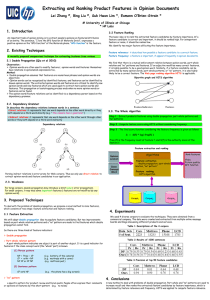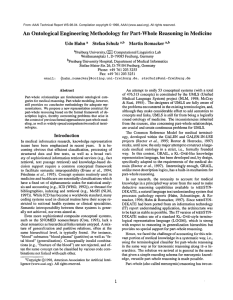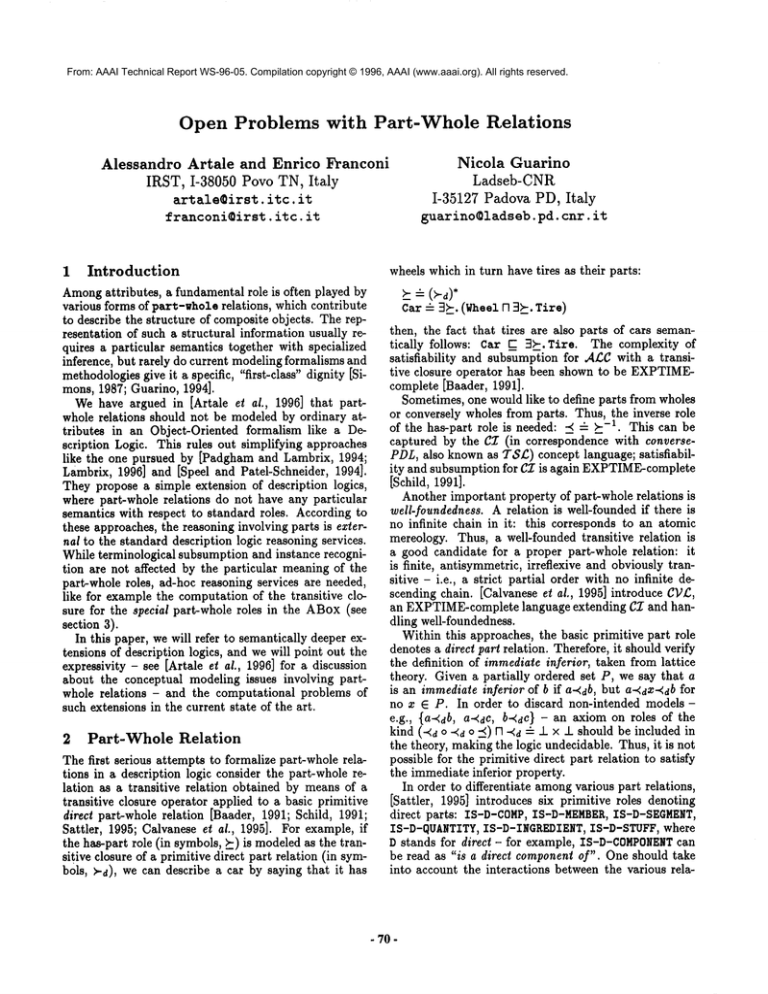
From: AAAI Technical Report WS-96-05. Compilation copyright © 1996, AAAI (www.aaai.org). All rights reserved.
Open Problems
with Part-Whole
Alessandro Artale and Enrico Franconi
IRST, 1-38050 Povo TN, Italy
Nicola Guarino
Ladseb-CNR
1-35127 Padova PD, Italy
artale@irst.itc.it
franconi@irst.itc.it
1
Introduction
Amongattributes, a fundamental role is often played by
various forms of part-whole relations, which contribute
to describe the structure of composite objects. The representation of such a structural information usually requires a particular semantics together with specialized
inference, but rarely do current modeling formalisms and
methodologiesgive it a specific, "first-class" dignity [Simons, 1987; Guarino, 1994].
Wehave argued in [Artale et al., 1996] that partwhole relations should not be modeled by ordinary attributes in an Object-Oriented formalism like a Description Logic. This rules out simplifying approaches
like the one pursued by [Padgham and Lambrix, 1994;
Lambrix, 1996] and [Speel and Patel-Schneider, 1994].
They propose a simple extension of description logics,
where part-whole relations do not have any particular
semantics with respect to standard roles. According to
these approaches, the reasoning involving parts is external to the standard description logic reasoning services.
While terminological subsumption and instance recognition are not affected by the particular meaning of the
part-whole roles, ad-hoc reasoning services are needed,
like for example the computation of the transitive closure for the special part-whole roles in the ABox(see
section 3).
In this paper, we will refer to semantically deeper extensions of description logics, and we will point out the
expressivity - see [Artale et al., 1996] for a discussion
about the conceptual modeling issues involving partwhole relations - and the computational problems of
such extensions in the current state of the art.
2
Part-Whole Relation
The first serious attempts to formalize part-whole relations in a description logic consider the part-whole relation as a transitive relation obtained by means of a
transitive closure operator applied to a basic primitive
direct part-whole relation [Baader, 1991; Schild, 1991;
Sattler, 1995; Calvanese et al., 1995]. For example, if
the has-part role (in symbols, _) is modeledas the transitive closure of a primitive direct part relation (in symbols, ~-d), we can describe a car by saying that it has
Relations
guarino~ladseb,pd. cnr. it
wheels which in turn have tires as their parts:
____. -- (~’d)*
Car--"3_~.(Wheel
F]3_~.Tire)
then, the fact that tires are also parts of cars semantically follows: Car [" 3~-. Tire. The complexity of
satisfiability
and subsumption for .A~C with a transitive closure operator has been shown to be EXPTIMEcomplete [Baader, 1991].
Sometimes, one would like to define parts from wholes
or conversely wholes from parts. Thus, the inverse role
of the has-part role is needed: ~ - ___-1. This can be
captured by the CZ (in correspondence with conversePDL, also knownas T8£:) concept language; satisfiability and subsumption for CZ is again EXPTIME-complete
[Schild, 1991].
Another important property of part-whole relations is
well-foundedness. A relation is well-founded if there is
no infinite chain in it: this corresponds to an atomic
mereology. Thus, a well-founded transitive relation is
a good candidate for a proper part-whole relation: it
is finite, antisymmetric, irreflexive and obviously transitive - i.e., a strict partial order with no infinite descending chain. [Calvanese et al., 1995] introduce C1~£:,
an EXPTIME-completelanguage extending g27 and handling well-foundedness.
Within this approaches, the basic primitive part role
denotes a direct part relation. Therefore, it should verify
the definition of immediate inferior, taken from lattice
theory. Given a partially ordered set P, we say that a
is an immediate inferior of b if a.~db, but a-~dX-~dbfor
no x E P. In order to discard non-intended modelse.g., {a-~db, a-~dC, b-~dC} - an axiom on roles of the
kind (’~d o -~d o _) ~ -~d -- _1. × .[. should be included
the theory, makingthe logic undecidable. Thus, it is not
possible for the primitive direct part relation to satisfy
the immediate inferior property.
In order to differentiate amongvarious part relations,
[Sattler, 1995] introduces six primitive roles denoting
direct parts: IS-D-COMP,
IS-D-MEMBER,
IS-D-SEGMENT,
IS-D-QUANTITY,
IS-D-INGREDIENT,
IS-D-STUFF,
where
D stands for direct - for example, IS-D-COMPONENT
can
be read as "is a direct component of". One should take
into account the interactions between the various rela-
- 70 -
tions so that, for example, the composition of Member/Collection with Component/Object results in the
Component/Objectrelation. In order to express such interactions, complex roles are needed; the language C27 is
enough to express these requirements. However, in order
to express also disjointness amongdifferent part-whole
relations, conjunction of roles is needed: such language
is at least as expressive as 7"8£:T~[Schild, 1991], which
is still an open problem.
Moregenerally, it is useful to differentiate amongseveral different part names: while modeling composite individuals it seems natural to give specific names to attributes denoting parts [Artale et al., 1996]. In the domain of artifacts, we can consider for example the individual carl of type Car. A first modeling choice amount
to saying that it has a part which is a wheel:
Car(carl ) A wheel1 ~_carl A ~eel( wheell
On the other hand, a second modeling choice can make
use of the attribute H/S-WHEEL:
Car(carl) A HAS-WIIEEL(carl,wheel1)
A l~a**l(wheell ).
In this latter case, we have the hidden assumption that
HAS-WHEEL
is a kind of part attribute:
vxy. HAS-WS~.~.L(x,
y) ~ y_~x.
Under such assumption, the latter formulation implies
the former. The possibility of expressing hierarchies of
roles is needed, and in particular for the transitive role.
The sub-part role can be simulated with role conjunction
involving the transitive role, whichis still - as said before
- an open problem.
vs Intensional
3W.3W.C E 3W.C,
i.e., wholes having sub-parts which have sub-parts themselves of a certain kind are not derived as wholes having
directly sub-parts of that specific kind. The same limit
applies also for the structural descriptions (see next section), at least as it is seen in the current systems.
On the other hand, approaches based on the modal interpretations of description logics [Schild, 1991; Sattler,
1995; Calvanese et al., 1995], do suffer of a dual limitation. Several properties which do hold at the TBox
level, and which are correctly taken into account in the
intensional reasoning process, do not hold any more at
ABoxlevel. The most famous example for this is antisymmetry of the part-whole relation. Antisymmetry
is usually a required property for the part-whole relation, since it captures acyclicity - i.e., an object can
not be part of another object having it as part. It is
knownthat antisymmetr~ does not affect logical implication in modal formulae . That is, a modal theory at TBoxlevel - can easily take into account antisymmerry, since TBoxreasoning does not change. But the
problem arises when introducing statements about individuals. Current approaches can not correctly reason at
ABoxlevel, by taking into account antisymmetry. In
fact, it is not possible to check the inconsistency of an
ABoxof the following kind - which is a non-intended
model for the part-whole relation:
a-(b, b-~c, c-~a.
Another way to represent the part-whole relation, is
to have a specific transitive role in the language, without having at the same time the primitive direct part
relation. This extension has been analyzed in [Sattler,
1996]; it is in correspondence with the union of multimodal K and $4 - i.e. K4,. Satisfiability
and susbumption in ,4£:C with transitive roles have been proved to
be PSPACE-complete. This approach seems definitely
to be more promising from a complexity point of view.
Another point in favor of this approach is the debatable
status of the direct part-whole relation in a conceptual
modeling framework: we do not see the usefulness of
having the direct part-whole relation in an ontology of
the physical world.
3 Extensional
1994; Lambrix, 1996; Speel and Patel-Schneider, 1994].
The main reasoning task is, of course, the computation
of the transitive closure for the part-whole roles. What
is missed by these approaches are TBoxreasoning like
4
Reasoning
There are two main approaches in the literature
when
considering reasoning with part-whole relations. In the
first approach - the easier one - complete reasoning over
parts and wholes is carried on only for individuals at
ABoxlevel. That is, the knowledge on parts and wholes
at TBox level is used as a constraint for the ABox
statements, and it is ignored for intensional reasoning.
This is the approach pursued by [Padgham and Lambrix,
Dependency
among parts
In order to correctly modelthe notion of a whole, we cannot limit ourselves to describing its meronymicstructure,
but we should be able somehowto express how the whole
is related to the parts, and howthe parts are "glued together" to form a whole. Important cases are essential
parts- the whole is generically dependent on a particular class of parts, dependentparts - a part is generically
dependent on the whole, exclusive parts- there exists at
most one whole containing a particular part.
Such features, characterizing the interdependence between the parts and wholes, can be expressed using qualified numberrestrictions on complexroles [Sattler, 1995;
Baader and Sattler, 1996]. For example, one could say
that a given tank is used exclusively by the reactors of a
given system in the following way:
Tank E
(= 1 (IS-D-COMPo IS-D-COMP)System)
VIS-D-COMP.
(~ReactorU 3IS-D-COMP.
System)
1 Modalformulae can not distinguish betweenantisymmettic and not antisymmetricstructures.
- 71 -
instance certain locative properties (e.g., "being in the
car park") of the whole hold also for its parts:
The limit of this representation is the requirement that
there exists a chain of direct part relations with a predefined length connecting the part with the whole. Thus,
this works only if the Tank has been actually defined as
being a direct part of a direct part - the &eactor - of a
System.
A more general notion of exclusive part is needed. It
is an open problem verifying whether it is possible to
express in description logics the notion of exclusive parts,
according to the following definition: x is an exclusive
part of y iff x is part of y and for all w such that z
is part of w then w is part of y. A possible limited
way to express it - using qualification - is shownby the
following example, where the Tank is an exclusive part
of a given System:
Car-----"
3(<~L0CATION).
Car-Park
173_.Engine
I"I...
i.e., a car has, amongother things, an engine and it is
located in a car park. Please note the use of the "<~"
distributive plural quantifier, whichexpresses the left distributive reading:
(<~R)(a,b) iff Vz. _(a,z)--*
Given the definition of ear, it follows that the engine is
also in the ear park:
Car E 3LOCATION.
Car-Park
CarE 3>-.(Engine
I-I3LOCATION.
Car-Park)
Tank C (= 1 _~ System) R V_~. (= 1 ~ System)
Having qualified number restrictions is an hard problem
anyway. [De Giacomo and Lenzerini, 1995] show the
complexity of satisfiability
for CIQ - a language admitting qualified number restrictions only on boolean combination of primitive roles and inverses of them - being
in the EXPTIME
class. It is not knownwhat it happens
if a complexrole - like the composition of two direct part
roles or the transitive "___" role - appears in the number
restriction: these are languages including .A/:C+A/’(o)
recently argued to be undecidable - and .A/:C+.Af(-J-) as
defined in [Baader and Sattler, 1996].
Another kind of dependency between parts - known
in the KRcommunityas structural description - characterizes the integrity of the whole. It will suffice here to
report the classical exampleof an arch which can be considered as a whole made out of inter-related parts. For
an arch, its parts should satisfy the following constraints:
the lintel is SUPPORTED-BY
the uprights, and each upright is ON-THE-SIDE-OF
and NOT-CONNECTED-WITH
the
other. Both [Padgham and Lambrix, 1994] and [Sped
and Patel-Schneider, 1994] propose an extension of description logics, where constraints amongrole fillers and in particular amongparts - can be asserted in the
definition of concepts:
Arch E
(--1 LINTEL)
lq
(= 2 UPRIGHT)
In general, it is also true that the location of a car is the
same of its engine:
1
Car E_ (LOCATION(~ o LOCATION))
Wespeak of upwarddistributivity when there are properties which the whole inherits from its parts: in many
cases, for instance in the medical domain, you want to
say that the whole is defective if one of its parts is defective.
The above mentioned downward and upward distributivity properties can be both referred to as property inheritance through parts. On the other hand, we can introduce property refinement through parts. This covers
the case where an object related to a whole is also related to its parts. Stating, for example, that when an
object is located in a region - say, r - then it is also
located in any region that contains r, wouldvalidate the
common-senseinference that a fracture of the condyle of
the femur is a fracture of the femur, too. However,such
principle of distribution is neither true for all roles nor
globally true for the same role (for example, a scoliosis
of the thoracic spine is not a scoliosis of the spine, and
therefore the LOCATION
role does not distribute). To address this problem, we can make use of the "I>" right
distributive plural quantifier locally to a role:
( I>R)(a, b) iff Vz. __.(b, z) --+ R(a,
For instance, from the following definitions2:
(constraint LINTELSUPPORTED-BY
UPRIGHT)
Femur-Fracture
--"
Fracture
I"I
3LOCATION.
Femur
Suchan extension recalls a simplified version of role value
map, and it is proved to be decidable in [Hanschke, 1992],
where a sound and complete algorithm is provided.
5
Femur-Condyle-Fracture
--"
FractureR
3( I:>__ LOCATION).
(Condyle3__
..Fem
ur)
Distributing over Parts
In this section, we will consider dependencerelationships
between properties of parts and wholes and how they can
be captured using the plural quantifiers [Franconi, 1993].
Wespeak of downwarddistributivity
when there are
properties which the parts inherit from the whole. For
R(x,b)
Spine-Scoliosis
--"
Scoliosis
[’I
3L0CATION.
Spine
2Weindicate with <l-~ and I>-~ the distributivity operators with respect to the 7ole __. (ispart o]).
- 72 -
Thoracic-Scoliosis
-Scoliosis R
3LOCATION.
(Thoracic-Spine R 3~. Spine)
then we can derive that:
Femur-Condyle-Fracture _E Femur-Fracture
but not:
Thoracic-Scoliosis
___ Spine-Scoliosis
The decidability and the complexity of .A~Cwith the
transitive "-<" relation and the left and right plural quantifiers is still an open problem, mainly because distributive plural quantifiers recall role-value-maps - even if in
a simplified form [Schmidt-Schau6, 1989].
6
Conclusions
Part-whole relations have been extensively used in order to convey structural information. Wehave seen how
their semantic peculiarities pose a number of modeling
and reasoning problems, which require careful choices.
Most of these problems are related to logical and computational properties which regard the notion of partwhole, like the transitivity property, and the interrelations among parts and whole. We must observe, however, that no one of the current systems is able to comprehensively cover the requirements we have discussed.
The most interesting and promising research direction
to follow in the future is the use of a transitive role in
the logic, without having the primitive direct part relation - i.e. the multimodal K4n logic. This research
work is still at the beginning, and most of the interesting constructors are still missing, like complex nontransitive roles, functionality, inverse roles, and simplified role value maps.
References
[Artale et al., 1996] Alessandro Artale, Enrico Franconi,
Nicola Guarino, and Luca Pazzi. Part-whole relations
in object-centered
systems: An overview. Data
KnowledgeEngineering, 1996. In press.
[Baaderand Sattler,
1996] Franz Baader and Ulrike
Number restrictions
on complex roles in
Sattler.
description logics: A preliminary report. In Proc.
of the 5 th International Conference on Principles
of Knowledge Representation and Reasoning, Boston,
MA, 1996.
[Baader, 1991] Franz Baader. Augmenting concept languages by transitive closure of roles: An alternative
to terminological cycles. In Proc. of the 12 th IJCAL
pages 446-451, Sidney, Australia, 1991.
[Calvanese et al., 1995] Diego Calvanese, Giuseppe De
Giacomo, and Maurizio Lenzerini. Structured objects:
Modeling and reasoning. In Proc. of the 4th International Conference on Deductive and Object-Oriented
Databases, DOOD’95,Singapore, December 1995.
[De Giacomoand Lenzerini,1995]GiuseppeDe Giacomo and MaurizioLenzerini.
What’sin an aggregate:Foundations
fordescription
logicswithtuples
and sets.In Proc.of the 13 th IJCAI,Montreal,
Canada,1995.
[Franconi,
1993]EnricoFranconi.
A treatment
of plurals
andplural
quantifications
basedon a theory
of collections.Minds and Machines, 3(4):453-474, November
1993.
[Guarino, 1994] Nicola Guarino. The ontological level.
In R.Casati, B.Smith, and G.White, editors, Philosophy and the Cognitive Sciences, pages 443-456.
HSlder-Pichler-Tempsky, 1994.
[Hanschke, 1992] Philipp Hanschke. Specifying role interaction in concept languages. In Proc. of the 3 ~d
International Conference on Principles of Knowledge
Representation and Reasoning, pages 318-329, Cambridge, MA, October 1992.
[Lambrix, 1996] Patrick Lambrix. Part-Whole Reasoning in Description Logics. PhDthesis, Department of
Computer and Information Science, LinkSping University, Sweden, 1996.
[Padgham and Lambrix, 1994] Lin
Padgham
and Patrick Lambrix. A framework for part-of hierarchies in terminological logics. In Proc. of the J th
International Conference on Principles of Knowledge
Representation and Reasoning, pages 485-496, Bonn,
Germany, May 1994.
[Sattler, 1995] Ulrike Sattler. A concept language for
an engineering application with part-whole relations.
In A. Borgida, M.Lenzerini, D. Nardi, and B. Nebel,
editors, Proceedings of the International Workshopon
Description Logics, pages 119-123, Rome, Italy, June
1995. University of Rome"La Sapienza".
[Sattler, 1996] Ulrike Sattler. A concept language extended with different kinds of transitive roles. In Proc.
of the 20th GermanAnnual Conference on Artificial
Intelligence (KI-96), Dresden D, 1996.
[Schild, 1991] Klaus D. Schild. A correspondence theory
for terminological logics: Preliminary report. In Proc.
of the 12 ,h IJCAI, pages 466-471, Sidney, Australia,
1991.
[Schmidt-Schaut3, 1989] M. Schmidt-SchauB. Subsumption in KL-ONV.is undeeidable. In R. J. Brachman,
H. J. Levesque, and R. Reiter, editors, Proc. of the
1 ,t International Conference on Principles of Knowledge Representation and Reasoning, pages 421-431,
Toronto, Ontario, Canada, 1989. Morgan Kaufmann.
[Simons, 1987] Peter Simons. Parts: A Study in Ontology. Clarendon Press, Oxford, 1987.
[Speel and Patel-Schneider, 1994] Piet-Hein Speel and
Peter F. Patel-Sehneider. A whole-part extension for
description logics. In N. Guarino, S. Pribbenow, and
L. Vieu, editors,
Workshop Notes of the ECAI-94
Workshop on Parts and Wholes, pages 111-121, Amsterdam, August 1994.
- 73 -


